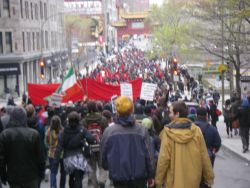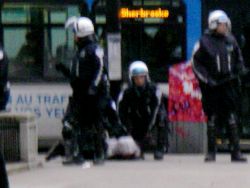From Peaceful Protest to Police Brutality
On May 1, 2012, thousands of students and other protesters took to the streets for the Anti-Capitalist rally in downtown Montréal. I attended the protest with a couple friends, and having read the “news” emanating from the “stenographers of power” (the mainstream media), it’s important to set the record straight about what happened here in Montréal.
The Montreal Gazette reported the events with the headline, “Police respond as May Day anti-capitalist protesters turn violent in Montreal.” This exact story and headline were carried across the English-speaking media fresh for the morning’s papers: with the Vancouver Sun, the Province, the Calgary Herald, the Regina Leader-Post, the Edmonton Journal, and the Ottawa Citizen.
The story, as they tell is, goes like this: it started peacefully just after 5 p.m. (this part is true!), and then it “was declared illegal by police at two minutes after 6 p.m. following violent clashes.” A police spokesperson (who apparently is the only person the media chose to interview for their article) said that, “injuries to a citizen, police officers and vandalism on cars and property were the reasons for declaring the march illegal.” The article then blamed “black-clad youth [who] were seen hurling rocks at store windows,” after which the police began to launch flash grenades, and the riot police moved in after 6 p.m. “using batons to disperse the crowd.” At 7:10 p.m., “a full hour after declaring the demonstration illegal, police announced that anyone who refused to leave would be arrested.”
The CBC went with the headline, “More than 100 arrests in Montreal May Day riot.” CTV reported that of the 100+ arrests that took place, “75 were for unlawful assembly, while the remaining 34 were for criminal acts.”
The first sign of trouble
So, arrested for “unlawful assembly”: what does that mean? It means that when the police unilaterally declare a protest to be “illegal,” everyone who is there is “unlawfully assembling,” and thus, mass and indiscriminate arrests can be made. In Part 1, Section 2 of the Canadian Charter of Rights and Freedoms, it is stated that “[e]veryone has the following fundamental freedoms”: conscience, religion, thought, belief, expression, media, communication, association, and “freedom of peaceful assembly.”
Having been at the protest from its beginning, I can say that it was a peaceful march. While there were individual acts of vandalism (the worst I saw was drawing on a bank’s window with a black marker), if police action were to be taken, it should be to arrest the specific vandal. Instead, they implemented collective punishment for exercising our “fundamental freedoms.”
The protest began in the Old Port of the city of Montréal, and made it’s way down rue Notre-Dame, up St-Laurent, and down to the financial district. The mood was good, people were in high spirits, with music, drums, the occasional fire cracker, young and old alike.
As we entered the financial district, the presence of the riot police became more apparent. When the protest made it to McGill College Ave. – crossing a wide intersection – as the march continued in its consistently peaceful path, the riot police quickly assembled alone the street below us. The crowd quickly became nervous as the protest was declared “illegal.” Before I could even take a photo of the police down the street in a long line, they began charging the crowd. Protesters dropped their signs and began up the street toward McGill University, while another section branched off along the intended direction, and others scattered.
The charge
The march had been successfully split, and the small factions were then being isolated and surrounded. Suddenly, riot police were everywhere, marching up the street like storm troopers, police cars, vans, horses, motorcycles, and trucks were flying by. As one faction of the protest continued down another street, the riot police followed behind, while another massive onslaught of riot police went around to block off the protesters from the other side. When the police first charged, I had lost one of my friends simply by looking away for a moment. After having found each other up the street, we watched as the protest which descended down the street was surrounded by police from nearly every side. It was then that we saw flash grenades and tear gas being launched at the crowd of people. There was a notable smell that filled the air.
As we stood, shocked and disturbed by what had just happened, we made our way toward McGill to see where other protesters were headed when we saw a group of riot police “escort” three young protesters whom they had arrested behind a police barricade at the HSBC (protecting the banks, of course!).
Up the street, and across from McGill, one protester who had run to get on the bus was chased down by several riot police who then threw him face-first onto the pavement, and as a crowd quickly gathered around (of both protesters and pedestrian onlookers), the police formed a circle around the man and told everyone to “get back!” and then they began marching toward us, forcing the crowd of onlookers to scatter as well. The police then took the young man over to where the other protesters were being “collected” at the HSBC.
Young man thrown to the ground
There was one young girl, with the notable red square patch on her jacket (the symbol of the Québec student movement) who had to be taken away on a stretcher into an ambulance. We don’t know what happened to her.
Girl taken away on a stretcher
As more and more police gathered, we decided it was time to leave, walking down the street through which the police had chased the protesters, remnants of signs, red patches, and other debris spilled across the streets; the remains of a peaceful protest ended with police violence.
This has become all too common in Montréal and across Québec, as the student protest enters its twelfth week, having had over 160 protests, an average of 2-3 per day. As the demonstrations take place, the police have used obscure and unconstitutional city by-laws in both Montréal and Québec City which are so vague in their descriptions that any peaceful assembly or march can be declared illegal. Those who are indiscriminately arrested are fined $500, and if arrested again, are charged between $3,500 and $10,500.
It is clear that the State has decided – unilaterally – that freedom of speech and freedom of assembly do not confirm to their specific “by-laws,” and are clamping down on students and protesters in order to quiet and crush the student strike and the emerging social movement which is being referred to as the ‘Maple Spring’. The national media, for its part, has decided to demonize the students, the protesters, and the people; taking the word of a “police spokesperson” over everyone else. Having been at the protest, however, I must question whether these so-called “journalists” were at the same event, because we witnessed two entirely different scenarios.
We entered the march in good spirits, and the police ended it in violence and repression, leaving us standing still, scattered, and disturbed; but our spirits are not crushed, our resolve is only growing stronger, and for each act of violence the police and State impose upon the people, we begin to see them for what they truly are, and thus, what is truly at stake: our very freedom, itself!














